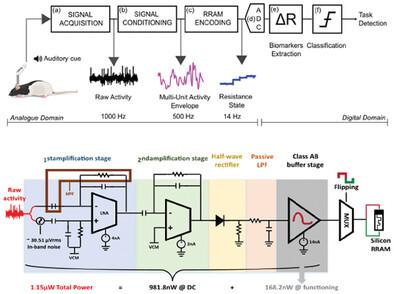当前位置:
X-MOL 学术
›
Adv. Electron. Mater.
›
论文详情
Our official English website, www.x-mol.net, welcomes your
feedback! (Note: you will need to create a separate account there.)
Neuronal Multi Unit Activity Processing with Metal Oxide Memristive Devices
Advanced Electronic Materials ( IF 5.3 ) Pub Date : 2024-11-06 , DOI: 10.1002/aelm.202400638 Caterina Sbandati, Xiongfei Jiang, Deepika Yadav, Spyros Stathopoulos, Dana Cohen, Alex Serb, Shiwei Wang, Themis Prodromakis
Advanced Electronic Materials ( IF 5.3 ) Pub Date : 2024-11-06 , DOI: 10.1002/aelm.202400638 Caterina Sbandati, Xiongfei Jiang, Deepika Yadav, Spyros Stathopoulos, Dana Cohen, Alex Serb, Shiwei Wang, Themis Prodromakis

|
Intra‐cortical brain‐machine interfaces (BMIs), able to decode neural activity in real‐time, represent a revolutionary opportunity for treating medical conditions. However, traditional systems focusing on single‐neuron spike detection require high processing rates and power, hindering the up‐scaling for neurons‐population monitoring in clinical application. An intriguing proposition is the memristive integrating sensor (MIS) approach, which uses resistive RAM (RRAM) for threshold‐based neural activity detection. MIS leverages analogue multi‐state switching properties of metal‐oxide RRAM to compress neural inputs by encoding above‐threshold events in resistance displacement, facilitating efficient data down‐sampling in the post‐processing, enabling low‐power, high‐channel systems. Initially tested on spikes and local field potentials, here MIS is adapted to process multi‐unit activity envelope (eMUA)—the envelope of entire spiking activity—which has recently been proposed as crucial input for real‐time neuro‐prosthetic control. Prior necessary modifications to the MIS for effective operation, this adaptation achieved over 95% sensitivity across two types of metal‐oxide devices: Pt/TiOx x
中文翻译:

使用金属氧化物忆阻装置进行神经元多单位活动处理
皮层内脑机接口 (BMI) 能够实时解码神经活动,为治疗疾病带来了革命性的机会。然而,专注于单神经元尖峰检测的传统系统需要高处理速率和功率,这阻碍了临床应用中神经元群监测的扩大规模。一个有趣的提议是忆阻积分传感器 (MIS) 方法,该方法使用电阻 RAM (RRAM) 进行基于阈值的神经活动检测。MIS 利用金属氧化物 RRAM 的模拟多态开关特性,通过在电阻位移中编码高于阈值的事件来压缩神经输入,从而促进后处理中的高效数据下采样,从而实现低功耗、高通道系统。最初在尖峰和局部场电位上进行测试,在这里 MIS 适用于处理多单位活动包络 (eMUA) - 整个尖峰活动的包络 - 最近被提议作为实时神经修复控制的关键输入。为了有效运行,在对 MIS 进行必要修改之前,这种调整在两种类型的金属氧化物器件(Pt/TiOx/Pt 和 TiN/HfOx/TiN)中实现了超过 95% 的灵敏度,证明了其与平台无关的能力。此外,对于 MIS 与硅芯片的集成,研究表明它可以将系统总功耗降低到 1 μW 以下,因为 RRAM 编码级放宽了对传统互补金属氧化物半导体 (CMOS) 前端的挑战的信号保持和噪声要求。这种 eMUA-MIS 适应为开发更具可扩展性和效率的临床 BMI 提供了一条可行的途径。
更新日期:2024-11-06
中文翻译:

使用金属氧化物忆阻装置进行神经元多单位活动处理
皮层内脑机接口 (BMI) 能够实时解码神经活动,为治疗疾病带来了革命性的机会。然而,专注于单神经元尖峰检测的传统系统需要高处理速率和功率,这阻碍了临床应用中神经元群监测的扩大规模。一个有趣的提议是忆阻积分传感器 (MIS) 方法,该方法使用电阻 RAM (RRAM) 进行基于阈值的神经活动检测。MIS 利用金属氧化物 RRAM 的模拟多态开关特性,通过在电阻位移中编码高于阈值的事件来压缩神经输入,从而促进后处理中的高效数据下采样,从而实现低功耗、高通道系统。最初在尖峰和局部场电位上进行测试,在这里 MIS 适用于处理多单位活动包络 (eMUA) - 整个尖峰活动的包络 - 最近被提议作为实时神经修复控制的关键输入。为了有效运行,在对 MIS 进行必要修改之前,这种调整在两种类型的金属氧化物器件(Pt/TiOx/Pt 和 TiN/HfOx/TiN)中实现了超过 95% 的灵敏度,证明了其与平台无关的能力。此外,对于 MIS 与硅芯片的集成,研究表明它可以将系统总功耗降低到 1 μW 以下,因为 RRAM 编码级放宽了对传统互补金属氧化物半导体 (CMOS) 前端的挑战的信号保持和噪声要求。这种 eMUA-MIS 适应为开发更具可扩展性和效率的临床 BMI 提供了一条可行的途径。


















































 京公网安备 11010802027423号
京公网安备 11010802027423号